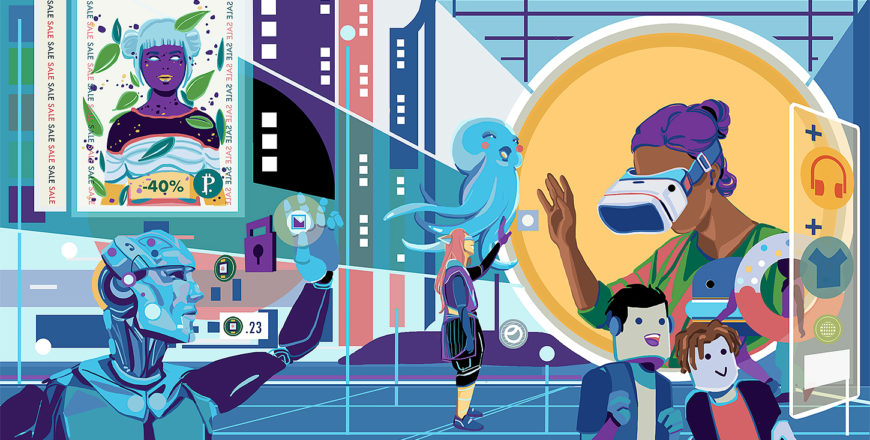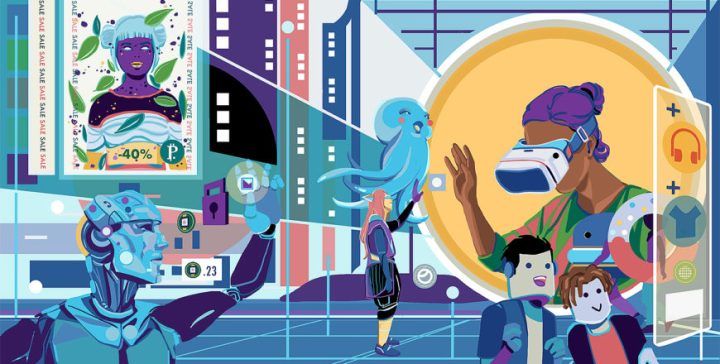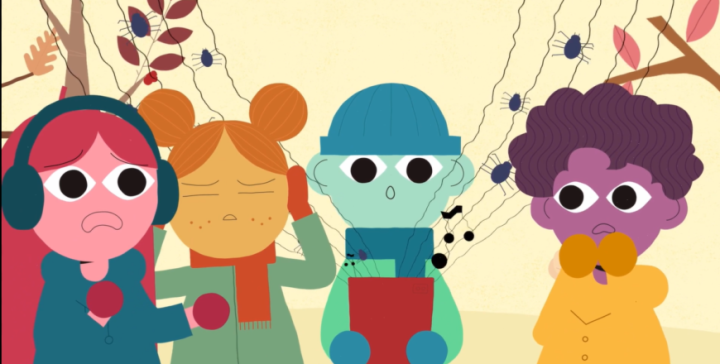What is the metaverse?
Metaverse is a concept that does not yet have a clear definition. It is used to predict how the internet of the future is going to be used in a social 3-dimensional virtual world.
The internet we are using is based on looking at texts and images with a web browser using a computer or phone. In the metaverse, 3D content is experienced in real time and personally, by moving around in the space as an avatar, a visual character, whose point of view dictates the way the virtual world is experienced. This is a familiar approach that has been used in many popular games, such as Minecraft or Fortnite, and the same experienced-based online behaviour is becoming increasingly common outside of games as well. Those children who have played and developed Roblox games will probably form the first metaverse generation, for whom being and acting on a 3D web is perfectly natural.
Metaverse is independent of any particular piece of technology. It can function on all platforms from web browsers to phones as well as on virtual reality (VR) headsets and augmented reality (AG) and mixed reality (MR) devices. It can be used for employee training, shopping, artistic experiences and, of course, playing. Millions of people are already playing in the so-called protometaverses, which include multi-player games or virtual worlds such Habbo Hotel and Second Life, but technologies such as VR headsets are not yet commonly used and there seems to be no clear need or audience for metaverses.
Who are we in the metaverse? Do we have digital twins in the metaverse? How do we protect them and transfer them from one platform to another? What does a digital identity look like in a 3D environment when the avatar has a face, clothes and a body? Fortnite characters and the like are already widely present in everyday life, and probably even more so in the future: characters become important to their users, as they receive cosmetic enhancements and gain experience points, friends and new types of content.
Who is building the metaverse? According to predictions, the metaverse will turn into a business worth billions of dollars in the course of this decade. Big companies such as Facebook, Google and Microsoft, are already building their own solutions but alternative solutions are also being built which are based on a different technology and philosophy of operations. This alternative, new internet is called Web 3.0 and it entails concepts such as personal ownership, block chains and crypto currencies. In open Web3 virtual worlds, such as Decentraland, all content is user-built and -owned.
The critique the metaverse has encountered is closely linked to its builders. Are big technology giants really able to build a fair internet, or could the metaverse just be a new way of showing ads, make money off brands and sell new technology? Will the various platforms be able to work seamlessly together to benefit the user, or will the different metaverses be entirely separate like the current internet? For example, what kind of user data is collected through a VR headset; can the user decide what information is collected and who it is shared with? For a long time, games have featured in-game purchases, which can be used for things like buying clothes for your avatar, but who does the money go to? For example, in the financial model of Roblox, only 30% of the profit goes to the makers of the game.
New ways of using the internet comes with both old and new challenges. What ethical questions does the metaverse entail? Will the metaverse become a place for people to hide from their real-life challenges and problems instead of trying to solve them. Can the internet of the future be even more addictive than the social media we have today? It is important that these questions are presented now while the development work is still in its infancy. In fact, various institutions, such as the European Union, have already taken a stance: The EU wants to see a metaverse that is open and not dominated by technology giants.
For more information on the metaverse and related phenomena, click on the links below:
EU and the metaverse: https://ec.europa.eu/commission/presscorner/detail/en/STATEMENT_22_5525
Matthew Ball’s short introduction to the metaverse: https://bigthink.com/series/the-big-think-interview/why-the-metaverse-matters/
Critical thoughts on the metaverse: https://www.wired.com/story/big-tech-metaverse-internet-consolidation-business/
Text: Marja Konttinen
Image: Siru Tirronen
CC BY 4.0
The media landscape of children and young people keeps changing, with new phenomena following each other back-to-back. Providing pupils with tools for understanding and processing these phenomena is important. This learning package is part of Pathways to New Media Phenomena – Information and Exercise Materials Series. The series includes information and exercises for the teacher and the pupils. You can explore new phenomena in a meaningful way with the help of the How to discuss new media literacy phenomena through pedagogical means method.
The learning package has been published by KAVI and the Finnish Safer Internet Centre project. The publication is continuation the publication series begun by the New Literacies development programme. The content of the publication is solely produced by KAVI and may not reflect the views of the European Union.

Material for the teacher
-
In the video, the Decentraland’s Marketing Director Marja Konttinen explains what the metaverse and Web 3.0. are, what the metaverse can look like and how people can become part of it. What are the opportunities and challenges provided by these virtual realities?
The video has English subtitles.
Web pages shown in the video
Google search: Metaverse
Meta: What is the metaverse https://about.meta.com/what-is-the-metaverse/
Pinterest search: Fortnite Skins https://www.pinterest.com.au/Alwaysaliya/fortnite-avatars/
How I Built the Entire Universe in Minecraft, ChrisDaCow https://www.youtube.com/watch?v=eAkb2mpybnM&ab_channel=ChrisDaCow
Decentraland: www.decentraland.org
Video introduction to the Metagallery: https://finnishmetagallery.fi
People, technologies & infrastructure – Europe’s plan to thrive in the metaverse I Blog of Commissioner Thierry Breton https://ec.europa.eu/commission/presscorner/detail/en/STATEMENT_22_5525 -
Teachers do not need to be experts and skilled at everything. Having a good control over one’s own speciality and pedagogics and being curious and enthusiastic about learning new things provide a great starting point for tackling new media phenomena. Approach to processing new media literacy phenomena encourages you to use your own expertise and competence when working with various phenomena.
Examine the model and consider the following questions:
- Based on your experience, what challenges does discussing new media literacy phenomena entail?
- What things support the discussing of new phenomena in your own work?
- How would you utilise the model to discuss the phenomenon at hand?
-
Media literacy is a transversal competence, whose promotion is required by the core curriculum of basic education (2014).
The objectives based on the core curriculum have been expressed separately for each school grade in the national descriptions of media literacy (the New Literacies development programme 2021). Basic education concerns the descriptions of good and advanced competences. The descriptions clarify the meaning of media literacy and the related objectives expressed in the core curriculum texts. The descriptions have been divided into three main areas: media interpretation and evaluation, media production and acting in media environments. You can learn more about the descriptions here.
Consider the following questions:
- How is the phenomenon under discussion structured in the media literacy competence descriptions?
- What kind of media literacy skills do the pupils learn in connection with discussing the topic?
-
You can refer to the materials of KAVI and the New Literacies development programme for support in the promotion of media literacy.
Media Literacy School (mediataitokoulu.fi) The Media Literacy School website brings together various learning resources and materials for the media education purposes of different age groups also in English.
The page Media Literacy School – New Literacies brings together a range of materials that were created within the development programme to support the media education of basic education. The materials produced in the programme can be found on the open learning materials website at AOE.fi.
Material for the pupil
-
- Metaverse is a concept that does not yet have a clear definition. It is used to predict how the internet of the future is going to be used in a 3-dimensional, social virtual world.
- In a metaverse, 3D content is experienced in real time and personally, by moving around in the space as an avatar, a visual character, that may possess characteristics not encountered in real life. This is already familiar to many from popular games, such as Minecraft or Fortnite.
- Metaverse is independent of any particular piece of technology. It can also work on all platforms from web browsers to phones. In addition, it can be used on virtual reality (VR) headsets and augmented reality (AG) and mixed reality (MR) devices. Technologies such as VR headsets are not yet commonly used and there seems to be no clear need or audience for metaverses that use them.
- The metaverse can be used for employee training, shopping, artistic experiences and of course playing.
- Millions of people are already playing in the so-called protometaverses, which represent the first, early versions of metaverses. These protometaverses include multi-player games or virtual worlds such Habbo Hotel and Second Life.
- Big companies such as Facebook, Google and Microsoft, are already building their own alternative metaverse solutions. This alternative, new internet is called Web 3.0, and it entails concepts such as personal ownership, block chains and crypto currencies.
- New ways of using the internet comes with both old and new challenges. The critique the metaverse has encountered is closely linked to its builders. Are technology giants really able to build a fair internet, or could the metaverse just be a new way of showing people ads? For example, what kind of user data is collected through a VR headset; can the user decide what information is collected and who it is shared with? Can the internet of the future be even more addictive than the social media we have today?
- The European Union has already taken a stance on the metaverse: The EU wants to see a metaverse that is open and not dominated by technology giants.
Text: Marja Konttinen
-
Discussion questions for the pupil
- Could the metaverse make the internet better? Consider the challenges of the current internet. Can these challenges be solved with technology?
- Imagine using a VR headset and walking in a futuristic, 3D shopping centre while you look for new clothes for your avatar. Would you grant the manufacturer of the device permission to track your eye movements and feelings, so that you could be shown ads that are tailored to your tastes? How would you feel if you were not asked for permission but, instead, your information would be collected and you would be tracked without you knowing?
Questions: Marja Konttinen
-
Activity exercise for the pupil
What is your digital identity like? A digital identity refers to your view of yourself in the digital world or transferring your own image to digital format.
- Who are you on social media? Do you behave differently online and in real life? Is your online character a reflection of you, or is your digital character a role or a performance? Who is the audience of your online character?
- Image yourself in five years’ time as an avatar in a 3D internet. Does your 3D avatar look like you, or is it completely different? What characteristics does it have (face, clothes, body)? How much importance do you place on determining your appearance in the metaverse? Think about the future when you will be studying or working. Do you think your student or work avatar will behave differently and look different from the avatar you will be using with your friends?
Exercise: Marja Konttinen
-

First consider all the familiar metaverse features you can find in the picture. Where in the picture lies the boundary between the real world and the metaverse? How do people travel from the real world to the metaverse?
Games that are located in the metaverse may have in-game purchases, which make it possible to buy additional features and advance in the game. What things in the picture refer to in-game purchases? Can you find various avatar characters in the picture? How can the avatars make use of the additional features of the game?
Text: KAVI
Image: Siru Tirronen




